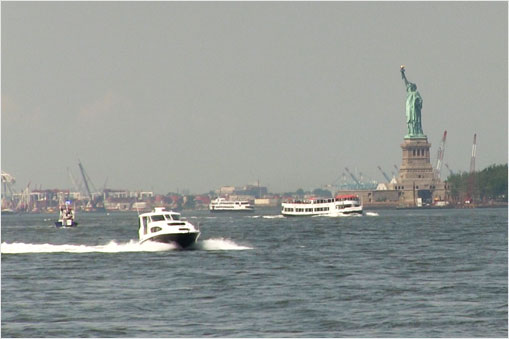 May 9, 2014 CONTACT: deppressoffice@dep.nyc.gov, (718) 595-6600 Department of Environmental Protection Completes $230 Million Project to Improve the Health of the East River and Long Island SoundUpgrades to the Tallman Island Wastewater Treatment Plant in College Point will Reduce Nitrogen Discharges and Increase Dissolved Oxygen Levels in the Surrounding WaterwaysOver the Last Decade DEP Has Invested More Than $1.5 Billion to Reduce Nitrogen Discharges from the City’s Wastewater Treatment PlantsPhotos of the Upgrades and Diagrams of the Plant can be Viewed on DEP’s Flickr PageNew York City Department of Environmental Protection (DEP) Commissioner Emily Lloyd today announced that DEP has completed a $230 million upgrade to the Tallman Island Wastewater Treatment Plant that will reduce the amount of nitrogen discharged from the plant into the Upper East River and Long Island Sound by more than 3,500 pounds per day, or nearly 1.3 million pounds each year. The upgrade will allow the plant to convert the organic nitrogen present in wastewater into inert nitrogen gas that can then be released harmlessly into the atmosphere before the treated water is released into the surrounding waterways. High levels of nitrogen can degrade the overall ecology of a waterway by reducing levels of dissolved oxygen and promoting excessive algae growth, especially in warm weather months. As part of an agreement with the New York State Department of Environmental Conservation (DEC), DEP has committed to reduce nitrogen discharges from its four wastewater treatment plants located along the Upper East River by nearly 60 percent by 2017. “The proper collection and treatment of wastewater is essential to protecting public health and our local waterways,” said DEP Commissioner Emily Lloyd. “New York City has invested more than $1.5 billion and has been a regional leader in nitrogen removal, ensuring that the East River and Long Island Sound are healthy and clean for fishing and other recreational uses.” “DEP continues to make good progress to meet New York City’s obligation to reduce nitrogen discharges by 58.5 percent into Long Island Sound,” said DEC Commissioner Joe Martens. “Completion of this phase one nitrogen reduction upgrade at the Tallman Island wastewater treatment plant is a critical component of the state's overall plan to improve the Sounds’ water quality for all New Yorkers. DEC looks forward to working with DEP as the phase two upgrades at all four of the city's East River treatment plants are constructed over the next 3 years.” Because nitrogen is not a pathogen and poses no threat to human health, New York City’s wastewater treatment plants were not originally designed to remove it from the treated water before it is discharged into a receiving water body. As part of an agreement with NY State and other environmental stakeholders, DEP has invested more than $1 billion to reduce nitrogen discharges from its four Upper East River wastewater treatment plants—Bowery Bay, Hunts Point, Wards Island and Tallman Island—which will reduce total nitrogen discharges from the plants by more than 58 percent. The newly installed biological nutrient removal technology at the Tallman Island plant required significant upgrades to the plant’s electrical substation, aeration system, and sludge pumping systems, and included the installation of sluice gates, mixers, diffusers, froth hoods, and a surface wasting system. In addition, a new sodium hypochlorite storage tank and delivery system were installed, and a mixed flow pump station was rehabilitated. In the plant’s air process system, four new blowers were installed in a newly constructed building. In addition to reducing the amount of nitrogen discharged from the plant, this investment will ensure that the facility remains in a state of good repair for decades to come. DEP also recently completed a $280 million nitrogen removal project at the Hunts Point Wastewater Treatment Plant, a $237 million nitrogen removal project at the Wards Island plant, and invested an additional $330 million in stabilization work and nitrogen reduction measures at the Bowery Bay facility. An additional $460 million was invested in similar upgrades at the Jamaica Bay and 26th Ward Treatment Plants, which discharge into Jamaica Bay. The Tallman Island Wastewater Treatment Plant is designed to treat 80 million gallons of wastewater per day from nearly half a million residents living in a nearly 17,000 acre area of Northeast Queens. In total New York City produces, and DEP collects and treats, an average of 1.3 billion gallons of wastewater each day and it is treated to federal Clean Water Act standards before it is discharged into local waterways. DEP manages New York City’s water supply, providing more than one billion gallons of water each day to more than nine million residents, including eight million in New York City. The water is delivered from a watershed that extends more than 125 miles from the city, comprising 19 reservoirs and three controlled lakes. Approximately 7,000 miles of water mains, tunnels and aqueducts bring water to homes and businesses throughout the five boroughs, and 7,500 miles of sewer lines and 96 pump stations take wastewater to 14 in-city treatment plants. In addition, DEP has a robust capital program, with nearly $14 billion in investments planned over the next 10 years that will create up to 3,000 construction-related jobs per year. This capital program is responsible for critical projects like City Water Tunnel No. 3; the Staten Island Bluebelt program, an ecologically sound and cost-effective stormwater management system; the city’s Watershed Protection Program, which protects sensitive lands upstate near the city’s reservoirs in order to maintain their high water quality; and the installation of more than 820,000 Automated Meter Reading devices, which will allow customers to track their daily water use, more easily manage their accounts and be alerted to potential leaks on their properties. For more information, visit nyc.gov/dep, like us on Facebook at facebook.com/nycwater, or follow us on Twitter at twitter.com/nycwater. | ||